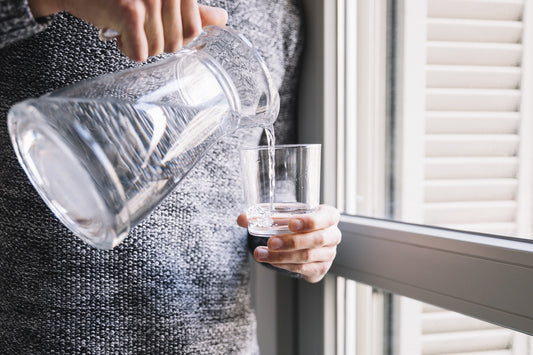Welcome to a comprehensive, step-by-step guide to installing an under-sink water filter at your home. This guide is designed to help you enhance the quality of your drinking water, ensuring it is cleaner, tastier, and healthier by efficiently filtering out harmful contaminants. Let's embark on this journey of transforming your tap water with a simple yet effective upgrade.
Introduction
Importance of Water Quality
The quality of the water you consume directly impacts your health and well-being. Unfiltered water can often contain harmful pollutants such as chlorine, lead, pesticides, and bacterial contaminants that can pose serious health risks. An under-sink water filter acts as a powerful barrier against these impurities, significantly improving the safety and quality of your drinking water.

Image by freepik
Benefits of Under-Sink Water Filters
Under-sink water filters offer several benefits that make them a preferred choice for many households:
- Enhanced Water Quality: These filters effectively remove a wide range of contaminants to provide you with clean and safe drinking water.
- Economical and Eco-Friendly: With an under-sink filter, you can avoid the costs and environmental impact of bottled water.
- Space-Saving Design: Installed neatly under the sink, these systems save countertop space and are hidden from view.
- Continuous Supply: They provide a constant source of water, unlike pitchers or other filtration methods that require frequent refilling.
Preparing for Installation
What You’ll Need
Before you begin the installation, gather the necessary tools and components to ensure a smooth setup:
- A quality under-sink water filter kit
- Adjustable wrench and screwdriver set for adjustments and fittings
- Teflon tape to secure and seal connections
- A bucket or basin to catch any water spillage
- A clean rag or towel to wipe down surfaces and clean up spills
Initial Steps
Preparation is key to a successful installation:
- Review the Manufacturer’s Instructions: Each model may have specific requirements or steps that are crucial for proper installation and function.
- Organize Your Space: Make sure the area under your sink is clean and clear of any items that might obstruct access to the plumbing.
The Installation Process
Step 1: Preparing the Filter
Secure the water filter unit to its bracket on the cabinet wall under the sink. Make sure that the filter is positioned correctly as per the manufacturer's guidelines to avoid any issues with water flow or filtration effectiveness.
Step 2: Plumbing Adjustments
Safety first—shut off the water supply to avoid any accidental water release. Using the adjustable wrench, disconnect the cold water hose from the sink's tap. It's normal for a little water to come out, so have your bucket ready to catch it.

Image by freepik
Step 3: Making Connections
Attach the filter's inlet hose to your cold water line. This connection is crucial as it directs the water into the filter for purification. Use Teflon tape to wrap the threading before connecting the hoses to ensure a watertight seal and prevent any leaks.
Step 4: Attaching the Water Line
Carefully attach the output hose from the filter system to your faucet’s water line. This hose will carry the filtered water to your tap. Secure all connections tightly to avoid any potential water leakage.
Step 5: Activating the Filter
With all lines connected and double-checked for tightness, turn the water supply back on. You might hear a gushing sound as air is pushed out of the pipes and the filter—this is normal. Run the faucet until the water runs clear and any air bubbles are expelled.
Post-Installation
Checking for Leaks
After installation, thoroughly check every connection for drips or moisture. Any wetness could indicate a loose connection, which needs immediate tightening to prevent water damage and ensure efficient filtration.
What to Expect Initially
At first, the water may appear cloudy or contain small charcoal particles; this is common with new filters and should resolve after the system has been flushed through with several gallons of water.
Maintenance Tips
Regular Check-Ups
Maintain your under-sink water filter by checking it regularly for any signs of leakage or wear. It's important to ensure that the system is functioning properly and efficiently.
When to Replace Your Filter
Filter cartridges need regular replacement to maintain optimal performance. The frequency of replacement depends on the manufacturer's guidelines and your usage but typically ranges from every six months to once a year.

Image by master1305 on Freepik
Conclusion
Installing an under-sink water filter is a proactive approach to managing your drinking water quality. It not only provides you with immediate access to purified water but also contributes to your long-term health and ecological sustainability.
FAQ
How often should I check my under-sink water filter?
Regular inspections every three months can help catch issues early, ensuring your system always operates at peak efficiency.
What are the signs that I need to replace my filter?
Reduced water flow, unusual taste or odor in the water, and visible sediment or particles all indicate that it might be time to replace your filter cartridge.
Can I install an under-sink water filter myself?
Yes, most homeowners can install an under-sink filter themselves using basic tools and following detailed instructions like those provided in this guide.
Do under-sink filters remove lead?
Many under-sink filters are specifically designed to reduce or eliminate lead and other heavy metals from your drinking water.
What should I do if my water tastes strange after installation?
Allow the system to flush and stabilize for a few days; if the issue persists, ensure all fittings are tight and consider replacing the filter cartridge if necessary.
Image by Freepik





